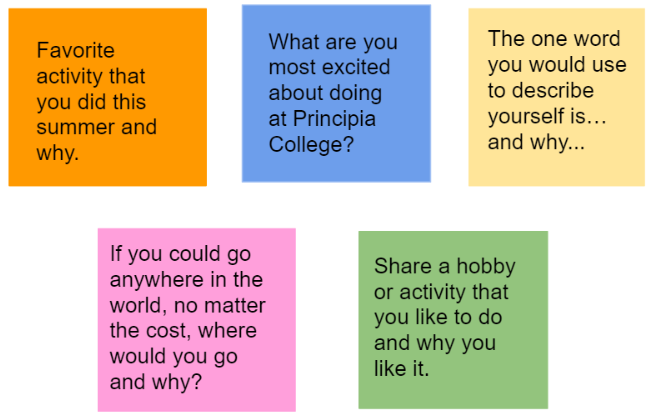Welcome back from the summer! It’s great to see the halls busy and classrooms packed. As you spend time discussing your course and expectations, remember to spend time getting to know the students. Whether you have a small or a large class, the value of making sure learners feel included in a class impacts everyone. I can remember being a student and having teachers who did not know my name, even in a small class. That was so discouraging to me, and I would often disengage from the course. I even remember being in courses where I couldn’t remember my classmates’ names. Speaking to them was challenging because I wanted to call them by their name, but I did not want to say the wrong name—so I often wouldn’t speak at all. Below you will find two practical get-to-know you icebreaker activities to help ease you and your students and to create more of an inclusive learning environment.
Colored Paper Activity (large class)
Students use quick discussion of topics you provide to get to know each other. (Feel free to use the picture below as your model/guide, or you can create other prompts.) First explain what the students will be doing. Display the prompts, like the picture listed below. Tell them they will be answering the prompts to their group/partner. Then hand out the pieces of paper with prompts. Before the students begin talking, have them say their names to each other. Then tell them how much time they’ll get to talk with each other. If the students finish before the time, encourage them to swap colors and share. Note: The number of students sitting together will determine how long they should spend on this. A pair of students should spend about 1-2 minutes, and a group of 8 could spend 5-7 minutes.

Talk-Pair-Share (small class)
- Provide prompts for the students. For my Monday class, I had the students share the following: their name, house, major or academic interest, hobby, and a fun fact. There are other prompts you could have them use as well.
- After you tell the students the prompts, explain that partner A will share his/her response of the prompts to partner B (talk). Then partner B will respond to the prompts to partner A (pair).
I recommend giving the students about 5 minutes or so to each share their ideas. Then bring all of the pairs together, and let each student share what he/she learned about his/her partner.
If you have any other icebreaker activities, feel free to leave your suggestion(s) below!
